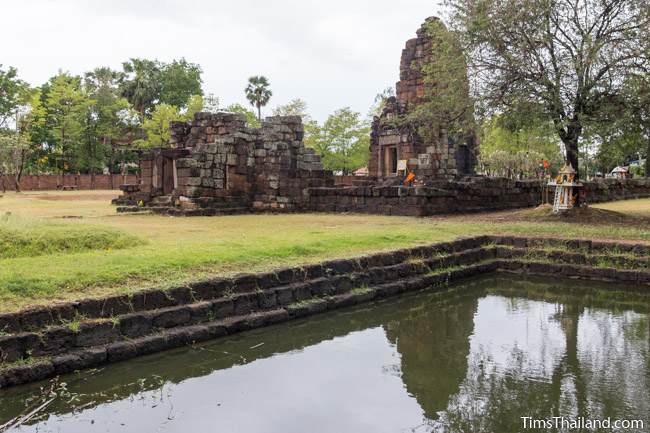Chaiyaphum Prang Ku Buddhist Temple, Thailand

Address
Chaiyaphum Prang Ku Buddhist Temple, Nai Mueang, Mueang Chaiyaphum District, Chaiyaphum 36000, Thailand
Diety
Buddha
Introduction
This khmer sanctuary is at Ban Nong Bua, Tambon Nai Mueang, 3 kilometres from the city. Prang Ku is a Khmer-style ancient site built in the 18th century. The main pagoda is square with a length of 5 metres on each side. A stone Buddha image in the meditation posture from the Dvaravati period. A building is situated in front of the pagoda surrounded by a wall. Everything is made of laterite except for the door and window frames, the lintel and columns that are made of sandstone. Locals offer the occasional flower garland and bathe the image in a yearly ritual held in April. The site is otherwise devoid of details save what appears to be a cracked depiction of the Hindu god Indra on a badly damaged sandstone lintel. Prang Ku is at Ban Nong Bua, Tambon Nai Mueang, 3 kilometers from the city.
Puranic Significance
The Bayon-style Prang Ku Chaiyaphum is the most complete Khmer ruin in the province, and a major point of pride for the capital city. It was built by King Jayavarman VII (r. 1182-1219) as a Mahayana Buddhist temple for one of the 102 arogayasala (hospitals) that he opened across the empire, and it follows the standard design: a small east-facing sanctuary with a single tower, an enclosure with just one gopura, a single bannalai between them on the south side, and a pond outside to the northeast; all built of laterite. The sanctuary’s front lintel has a Buddha sitting cross-legged atop a Kala face with two very faded (and thus unidentifiable) beings bowing before him while the pediment has a rather large four-armed Avalokiteshvara (the Bodhisattva of compassion) in the middle with two broken beings next to him. The middle portion of the sanctuary’s interior lintel is so damaged. The sanctuary’s final carving is a lintel above the north false door. In its center is a Buddha meditating protected by the naga and on the right is a four-armed Avalokiteshvara. And like the main sanctuary, there are guardian naga at the corners. Inside is a small yoni now used as a shrine. In most of these formerly Hindu shrines, the traditional yoni and lingam were replaced with meditating Buddha statues (although another source said one of these statues represents the monk Phra Sangkatchai). In the Prang Ku ruins, there is curiously a lingam and yoni just inside the eastern-facing gopura, the traditional entrance enclosure to most Khmer temples, regardless of the era. Considering that the arogayasala was a Mahayana Buddhist temple, it is likely that the lingam and yoni came from the ruined temple base ruins nearby. Above the entrance to the gopura is a lintel carving depicting, among other things, Indra and his mount, the 3-headed elephant Erawan.
Century/Period/Age
1182-1219
Managed By
UNESCO world heritage site
Nearest Bus Station
Chaiyaphum
Nearest Railway Station
Bua yai station
Nearest Airport
Khon Kaen (KKC)





